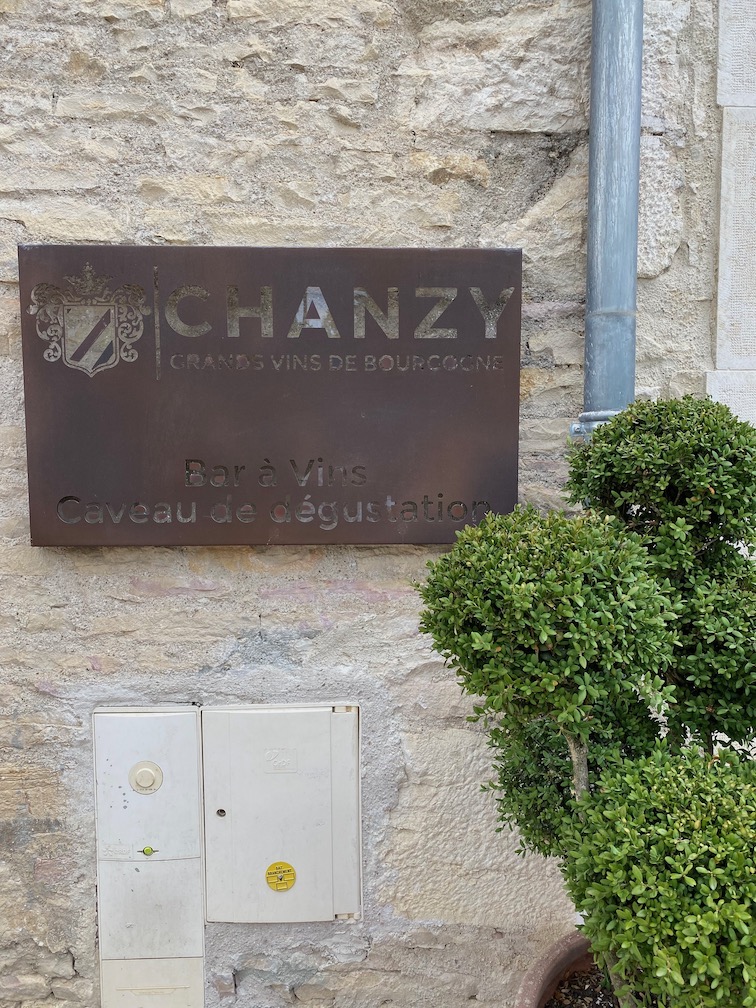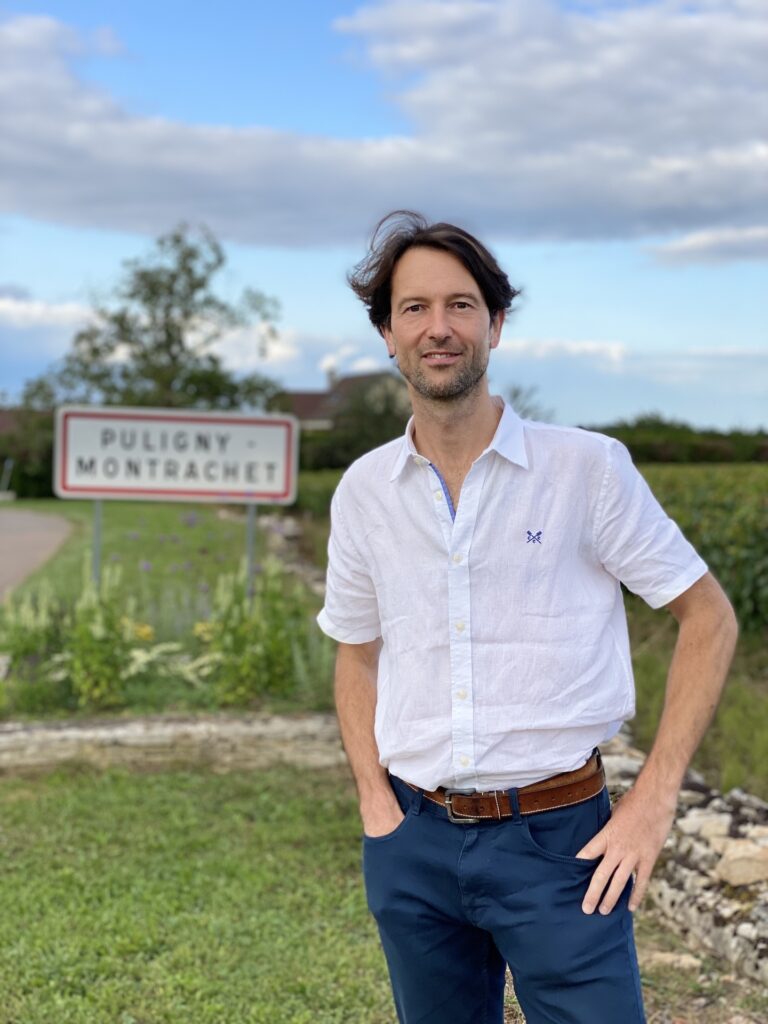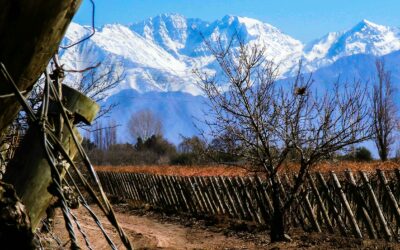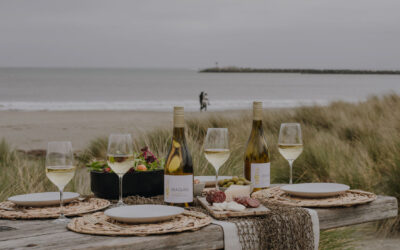This was my first introduction to Maison Chanzy. I heard about them just as I was leaving Alliance Wine to turn to freelance content writing.
Taking advice from my former boss, another fellow Burgundy lover, I bought a few bottles of their more affordable wines to try back in May and was really impressed. So I was keen to set up a visit.
Where Exactly is Maison Chanzy?
The Cotswold-like village of Puligny-Montrachet may look quaint and unassuming from the outside, but looks can be deceiving. Behind those limestone façades lies some of the world’s greatest white wine domains.
Being mildly obsessive about Chardonnay, and Burgundy in general, this is about the closest I’m going to get to wine utopia. Something my wife clearly noticed by my animations as we approached!
As we drive along the Rue des Creux de Chagny onto Place des Marroniers, it’s easy to spot the newly opened Maison Chanzy wine bar and tasting room on the opposite side of the square.
Occupying the former family home of Vincent Leflaive of Domaine Leflaive fame, the imposing 18th Century house now proudly bears the ‘Maison Chanzy’ name.

Chanzy’s Impressive Tasting & Events Venue
As we enter the building, it’s immediately apparent that its new owners have invested heavily here.
The fully-restored 16th Century vaulted cellars are the centrepiece for the wine bar and tasting room which extends outside, to the rear of the building, to a large terrace and courtyard-style garden.
The floor above is being converted into an impressive venue space.
Nicolas Corne, Chanzy’s head of digital sales and customer experience, is our host and begins by giving us a quick tour.
A Room Dedicated to Le Montrachet
My ears prick up when he shows us a smaller cellar off the main vaulted room which, he proudly tells us, will hold bottles of Le Montrachet from all 21 producers.
In other words, a collection of arguably the greatest single-vineyard Chardonnays that money can buy.
This, in itself, is worth a revisit!

Bouzeron: Maison Chanzy’s Spiritual Home
In 1974, Daniel & Catherine Chanzy bought and renamed a 50-year-old, 8 hectare domain in the commune of Bouzeron.
It lies between the villages of Rully and Santenay in the Côte Chalonnaise region of southern Burgundy.
Bouzeron village was promoted to AOC status in 1997 for its still white wine made exclusively from Aligoté. This makes it the only Village AOC in the entire Burgundy region dedicated exclusively to this grape.
Over the years, the Chanzy couple not only extended their Bouzeron holdings to 15 hectares, they purchased additional vineyards too.
Plots in nearby Mercurey, Santenay and Rully as well as further afield in Puligny, in the Côte de Beaune, and Vosne-Romanée, in the Côte de Nuits, took the domain to 38 hectares.
In 1997 they completed work on a new cellar and adjoining laboratory to accommodate their increased production. In 2001, Daniel and Catherine were officially joined by their son and daughter.

Maison Chanzy Changes Hands
In 2012, the Chanzy family sold their estate to another prominent wine family from Santenay aided by a group of investors. Five years later, this new consortium acquired a majority stake in Domaine Pagnotta, another local Chalonnaise producer.
This effectively doubled their vineyard holdings to 80 hectares and overnight, made them the largest vineyard landowner in the Côte Chalonnaise.
Chanzy Adds Top Burgundy Wines
The final crucial component in the Chanzy portfolio, that was instigated by Jean-Baptiste Jessiaume – the former group’s head winemaker, is the négociant side to the business.
Essentially, using long-term contracts, they gained access to grapes and white wine musts (freshly pressed grape juice) from some of the most prestigious vineyards in the entire region. In other words, Grand Crus and top Premier Cru wines in the Côte de Beaune and Côte de Nuits appellations.
A New Chapter at Chanzy
In 2019 Max Blondelle, former head winemaker for Domaine Chanson, joined the fold. He instigated a fairly radical change to the winemaking philosophy which is already showing great results in the newest vintages, some of which I tasted.
Max has a very ‘hands-off’ approach in the cellar and is more interested in expressing the key natural elements that affect the grapes. Namely the soils on which they’re grown.
The owners are also fully committed to sustainability and biodiversity in the vineyards. They’ve already achieved Haute Valeur Environnementale Level 3, the most respected certification for agriculture in France. They’re also joining a fast-growing trend in the region towards organic viticulture and all their vineyards are currently in conversion, aiming to be certified from the 2024 vintage.
More on Max’s Winemaking Philosophy
I ask Nicolas if Max is an advocate of using whole bunches in his red wine ferments, a trend that is becoming increasingly popular around the world for more vibrant, elegant wines. He explains that as Max is focused on terroir, texture and rounder tannins in his wines, he’ll use anything between 20-100% whole bunches in his ferments.
When it comes to oak, Max uses it sparingly to build texture or nuanced flavour rather than adding obvious structure or tannin. Although he prefers to use the traditional 228 litre Bourguignonne oak barrels at present, he’s open-minded enough to experiment and is currently trialling six foudres (very large used oak casks) as well as other intermediate sizes.
He’s also trialling four different coopers so he’s clearly a ‘details’ man. He replaces only 15% of his barrel stock every year saving the new oak mainly for the top Premier Crus and Grand Crus.
• For my notes on the whites tasted today, click here
• For my notes on the reds tasted today, click here




